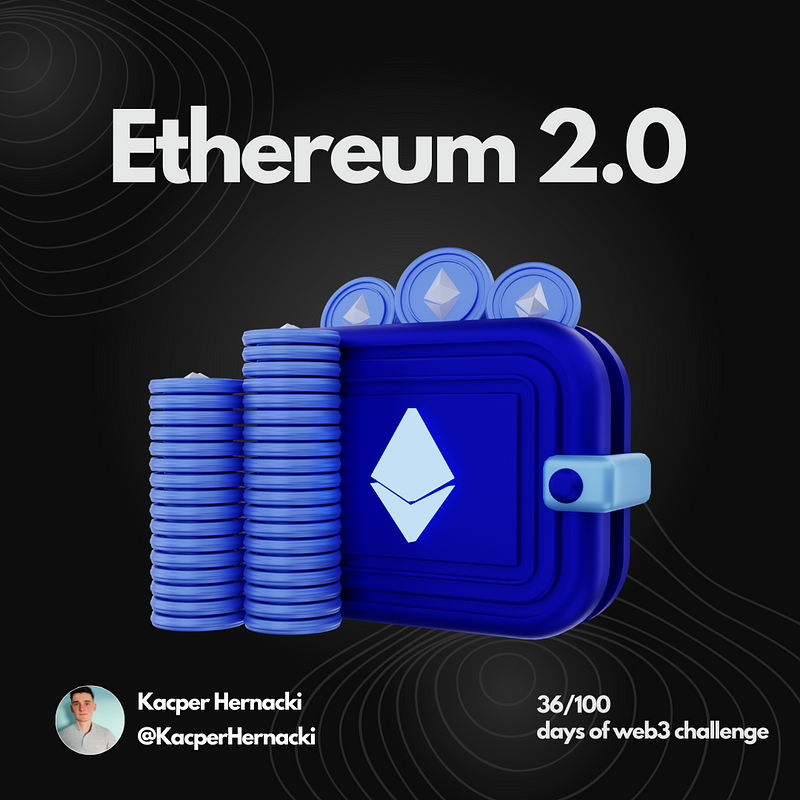Ethereum 2.0 — explained to a kid
To prepare this material I had to jump deep into topics related with the technology and tools used to improve ethereum network. It can…

To prepare this material I had to jump deep into topics related with the technology and tools used to improve ethereum network. It can help get a full view on this extremely important event from web3 world.
Agenda:
- intro,
- what is it?
- The merge,
- Problems it solves,
- Conclusion.
What is it?
Ethereum 2.0 is the big update of the Ethereum current network, which will mainly change the consensus model from proof of work to proof of stake. It means, that validation of new transactions will be proceeded by staking.
Proof of stake is presented below:
https://twitter.com/kacperhernacki/status/1546468490747559936?s=21&t=tgYWlYmW-g-K8vHOnrvkoQ
Proof of work is shown below:
https://twitter.com/kacperhernacki/status/1546190722675752960?s=21&t=tgYWlYmW-g-K8vHOnrvkoQ
Proof of work consumes a lot of power, which is used for solving hash algorithm, so it is considered as not efficient and eco friendly enough to stop attacks on cryptocurrencies at this field. Ethereum merge will reduce carbon footprint by up to 99,95%.
The merge
In different kind of roadmaps or informations about ethereum 2.0, there is used term “the merge”. Below is presented short definition:
The process of joining ethereum mainnet with proof of stake beacon chain is called “merging”.
It is extremely important to mention that, the beacon chain was run initially separately from mainnet. As mainnet uses proof of work and beacon chain proof of stake, the merging, joining them will permanently change the consensus model to the PoS.
More about the beacon chain is presented below:
https://twitter.com/kacperhernacki/status/1555861608756350976?s=21
Ethereum mainnet is containing all addresses and transactions since the beginnings — 2015. As beacon chain distributes only validators, is not validating any transactions, after merging the previous data will be kept.
Moreover, Ethereum will gain 63 more chains run in parallel, called shard chains. Main purpose of beacon chain is to coordinate them and at the end allow to join simultaneously transactions from their blocks to the mainnet.
More about shard chain is included there:
https://twitter.com/kacperhernacki/status/1555528796832501761?s=21
Problems it solves:
Current eth 1.0 network causes problems like:
- extremely high gas fees,
- high power usage,
- disk space usage,
- network congestion,
- Expensive GPUs.
Will eth 2.0 solve them all?
Network congestion and gas fees will be significantly lowered with sharding which is implemented to scale the network. Additional 63 chains will not only speed up transactions per second rate, but also decrease the congestion as well.
As gas fees are strictly related to the congestion, the dumping price will be obviously caught. Moreover, disk space will not be increased dramatically with these solutions, because each shard chain node is storing only data from own network.
Power needed to computing hash solutions also drop dramatically because of implemented proof of stake consensus model. It leads to extremely low requirements to become validator instead of expensive tools for mining.
Conclusion
Ethereum 2.0 will solve many problems in the network. It seems to be a perfect solution to the web3 world which is constantly developed and has incredible funds with each year, what leads to huge demand.
However, some of the critics claim that the merge is not a sufficient solution for scaling problem, time will give an answer if it is effective or needs more functionalities.
If you like my web3 challenge content, follow the repo with all topics included and many more…
Soon will add blockchain with typescript.
https://github.com/Kacper-Hernacki/100-days-of-web3-challenge-blockchain-free-materials




